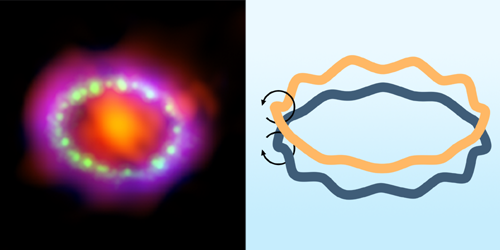A Supernova Remnant Shaped by Vortices
Around 20,000 years ago, as viewed from Earth, a massive star in one of the Milky Way’s satellite galaxies blew off a ring of gas and dust that then expanded into interstellar space. Its subsequent 1987 explosion was named supernova 1987A. Like a camera flash in a dark room, SN 1987A lit up its surroundings, revealing the gas-and-dust ring that the star had ejected millennia before. Images of that structure showed that material in the ring clumped together in discrete patches, a behavior that astronomers have struggled to explain. Now Michael Wadas and his colleagues at the University of Michigan, Ann Arbor, have come up with a new solution [1]. They propose that the clumps formed via the same fluid-dynamical phenomenon that can cause the trail of condensation behind an airplane to break into pieces.
The phenomenon in question is the Crow instability, and it’s triggered by the interaction of two counterrotating vortices. Wadas and his colleagues suggest that the ring of material ejected by SN 1987A’s progenitor started out as a pair of such vortices—imagine two expanding smoke rings, stacked one on top of the other, that twist in opposite directions. The researchers propose that small waves in the two toroids grew as the ring expanded, eventually causing the structures to touch in multiple spots. At locations around the ring between the contact points, a smaller vortex “pinched off,” becoming the core of one of the ring’s clumps. In simulations, the researchers produced rings with similar numbers of clumps as appear in the ring around SN 1987A. Wadas says that stars known to be surrounded by similar gas-and-dust rings could be good observational targets to test the theory further.
–Marric Stephens
Marric Stephens is a Corresponding Editor for Physics Magazine based in Bristol, UK.
References
- M. J. Wadas et al., “Hydrodynamic mechanism for clumping along the equatorial rings of SN1987A and other stars,” Phys. Rev. Lett. 132, 111201 (2024).




